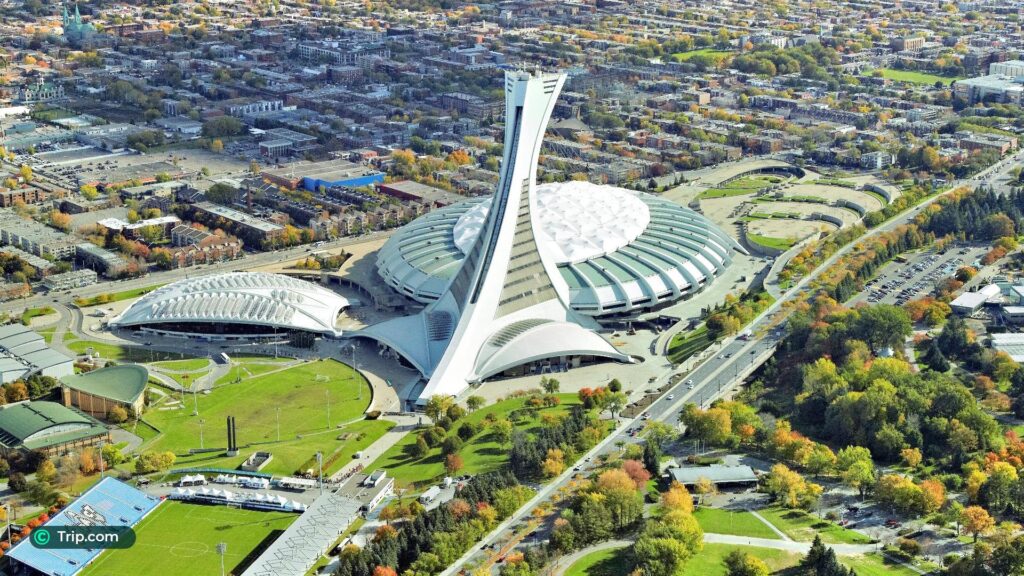Canada has a diverse array of stadiums that seamlessly blend the thrill of athletic competition with architectural brilliance, from the urban landscapes of Toronto to the picturesque settings of Vancouver. As we journey through the heart and soul of Canadian sports, we visit the country’s stadiums, each with its own distinct charm and aesthetic appeal. In this article, we celebrate “The 10 Most Beautiful Stadiums in Canada,” arenas that not only host breathtaking moments of triumph and defeat, but also serve as iconic symbols of design innovation.

10. Tim Hortons Field – Capacity: 23,218
The new stadium was constructed in 2013 and into early-mid 2014 on the site of the former Ivor Wynne Stadium, which was demolished in the process, and it opened for Canadian Football League (CFL) football in late 2014. The stadium currently seats approximately 24,000 spectators for Canadian football, with expansion potential to boost capacity to more than 40,000 seats for special events (such as hosting a Grey Cup contest) in the future.

09. Saputo Stadium – Capacity: 19,619
The stadium cost CA$17 million ($21.1 million in 2021 dollars) to build, with $7.5 million paid by the Saputo family and the rest financed on a 25-year term. Saputo Stadium is now CF Montréal’s administrative headquarters and also includes a training field, 34 corporate suites and full player welfare areas. The complex covers approximately 150,000 square metres (1,600,000 sq ft). It was designed and fabricated by Dant Clayton Corporation and built by Broccolini Construction Inc.

08. TD Place Stadium – Capacity: 24,000
TD Place Stadium (originally Lansdowne Park and formerly Frank Clair Stadium) is an outdoor stadium in Ottawa, Ontario, Canada. It is located at Lansdowne Park, on the southern edge of The Glebe neighbourhood, where Bank Street crosses the Rideau Canal.

07. Rogers Centre – Capacity: 41,500
Rogers Centre (originally SkyDome) is a multi-purpose retractable roof stadium in Downtown Toronto, Ontario, Canada, situated at the base of the CN Tower near the northern shore of Lake Ontario. Opened in 1989 on the former Railway Lands, it is home to the Toronto Blue Jays of Major League Baseball (MLB).

06. IG Field – Capacity: 32,344
IG Field (formerly Investors Group Field) is an outdoor stadium in Winnipeg, Manitoba. The stadium, which opened in 2013, is located on the University of Manitoba campus next to University Stadium.
The stadium has a capacity of 33,134 and is partially covered. The stadium contains a corrugated metal roof, restaurant, 52 suites, walk of fame and other amenities.

05. Mosaic Stadium – Capacity: 33,350
Mosaic Stadium is an open-air stadium at REAL District in Regina, Saskatchewan.
The stadium soft opened with a university football game between the Regina Rams and the Saskatchewan Huskies on October 1, 2016. The Roughriders moved into the stadium for the 2017 CFL season. It hosted the 2019 NHL Heritage Classic and the 109th Grey Cup in 2022.

04. Olympic Stadium – Capacity: 56,040
Olympic Stadium is a multi-purpose stadium in Montreal, Canada, located at Olympic Park in the Hochelaga-Maisonneuve district of the city. Built in the mid-1970s as the main venue for the 1976 Summer Olympics, it is nicknamed “The Big O”, a reference to both its name and to the doughnut-shape of the permanent component of the stadium’s roof.

03. Commonwealth Stadium – Capacity: 56,302
Commonwealth Stadium located in the McCauley neighbourhood of Edmonton, Alberta, Canada.
Commonwealth Stadium has a seating capacity of 56,302, in an all-seater configuration. The stadium has two twin-tier grandstands along each side, and single-tier stands on the corners and ends. The sides feature 44,032 seats, with the remaining 12,386 in the corners and ends. The side seats are 53 centimetres (21 in) wide and have a cup holder, a feature lacking on the narrower end zone seats. The seating is laid out in a colorized mosaic pattern, with dark green at the bottom, yellow in the middle and lighter green at the top. In the sides there are 14,203 dark green seats, 19,019 yellow seats and 10,810 light green seats. In the corner and end zones there are 8,672 dark green and 3,713 yellow seats. There are 15 executive suites on the east stand, 7 on the west stand and 8 on the south end zone. There is a limited amount of covered seating on the upper sections of the lower tier on the sides; half of this section on the east stand is a media centre.

02. BC Place – Capacity: 54,500
BC Place is a multi-purpose stadium in Vancouver, British Columbia, Canada. Located at the north side of False Creek, it is owned and operated by the BC Pavilion Corporation (PavCo), a crown corporation of the province.
Opened on June 19, 1983, BC Place was originally an indoor structure with an air-supported roof, the world’s largest at the time.
Following the 2010 Winter Olympics, it was closed for 16 months as part of an extensive revitalization, the centrepiece of which was replacing the inflatable roof with a retractable roof supported by cables. Once construction was completed, the stadium’s new roof was also the largest of its type.

01. BMO Field – Capacity: 27,980
BMO Field is an outdoor stadium located at Exhibition Place in Toronto, Ontario, Canada.
From 2014 to 2016, the stadium underwent a series of major renovations, which added an upper deck to the east grandstand and a roof over the seating areas, and lengthened the field to make it suitable for hosting Canadian football. The latter allowed for the Toronto Argonauts to move to BMO Field beginning with the 2016 CFL season, which also saw the 104th Grey Cup played at the stadium. It is one of two Canadian stadiums which will host matches of the upcoming 2026 FIFA World Cup. An expansion for the tournament will bring the stadium’s capacity to 45,736 seats.














